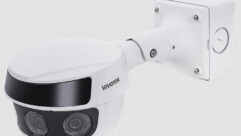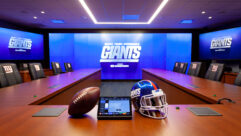Ten years ago, marketers and ad agencies could only dream of having the ability to gather real intelligence about individuals who were standing in front of a billboard, entering a retail shop, and gathering around an outdoor event. The most they could hope for was circumstantial data gathered from an uptick in sales or hiring college students to stand outside with a clipboard.
In a global environment where people are more concerned than ever about personal data being shared or sold, technology companies have been developing ways to glean pertinent intelligence on consumers without invading privacy using artificial intelligence (AI) and the Internet of Things (IoT).
From dash-cams to video doorbells, to security cameras on every street corner and inside every store, consumers have become accustomed to the fact that they are being watched.
MORE THAN A PRETTY FACE
Display manufacturers are claiming surfaces once occupied by massive static billboards down to the smallest point-of-purchase display. These active displays create longer linger times and have the potential to engage the viewer. Add cameras, sensors, beacons, and IoT to these digital displays, and a whole new world of data is available to marketers and analysts in every vertical market.
Some major display manufacturers such as Samsung, LG, and NEC have developed and continue to evolve intelligent software solutions to create a converged ecosystem.
At its first Artificial Intelligence (AI) Summit in January 2018, Samsung Research America brought together more than 300 leading academics, technical experts, and university students to explore ways to accelerate AI research and to understand the best commercial applications of AI. “Artificial Intelligence and machine learning are becoming mainstream, used by millions each year. Yet, we need more collaboration in the industry—from companies to academics and researchers— to let AI flourish,” said senior vice president of AI research, Dr. Larry Heck. “It’s time for us to find new ways to work together to ensure AI serves the needs of people, first and foremost.”
“As we see AI technology continue to proliferate, businesses have begun to consider AI’s role beyond the home,” said Garry Wicka, head of marketing at LG Electronics USA Business Solutions. ThinQ is the umbrella name for LG’s AI technology that includes voice control and learns and adapts over time. “Our core approach is open platforms, open partnerships, open connectivity. As LG continues to drive innovation in the commercial display industry, we’ll also continue to consider the ways that our products enhance the end-user experience.”
NEC’s ALP uses edge and cloud computing to deliver real-time insights. Consumer demographic data—including age and gender, traffic patterns, dwell time, and impression data—is fed into a locally based edge appliance, which then triggers targeted messages and promotions at the digital signage media player level.
“Big data analytics, delivered into the cloud, will provide retailers with content insights such as impact on sales, demographics and audience traffic, overall engagement with customers, and which content triggered the most positive customer experiences,” said Richard Ventura, vice president of strategic management at NEC Display Solutions of America, and immediate past chairman of the Digital Signage Federation. “The platform’s data analytics capability gives retailers the power to deliver the right message or content to the audience because it answers the questions of who the customer is and which piece of content was most successful in creating a meaningful engagement. Using this data, NEC ALP is able to draw a direct correlation between when content was played, the number of impressions, and what the conversion rates are to actual sales.”
For display manufactures not getting into the software business, there are powerhouse options. “Backend software solutions from companies such as Microsoft, Google, and Intel, among others, offer display manufacturers a complete ecosystem and alliance opportunities that help deliver complete solutions,” said Andy Chien, product marketing manager, ViewBoard at ViewSonic. “Hardware manufacturers don’t have to worry about developing everything themselves, but rather focus on creating the best displays that can optimize and be compatible with current and future technologies.”
CONTEXTUALIZING PIXELS AND DATA
The convergence of AI and contextually rich data received by IoT sensors will shape the next few years.
Looking toward 2020, “the focus is going to be on multichannel customer behavior segmentation, and communicating to customers based on things like age, demographics, and shopping experiences,” according to NEC’s Ventura. Location-based sensing for marketing and communications, CRM and personalization, and mobile point of sale (POS) are all part of the equation.
Gathering data analytics is the easy part. As companies are utilizing more smart spaces in their environment, how and what companies do with that data is where the ROI lies. “Now they should be looking at how to use analytics to drive the customer journey,” Ventura said. That journey includes receiving real-time feedback to identify things like what might be causing somebody to leave the store and provide insight for optimizing pricing. Ventura added that companies will be able to make more informed decisions such as staffing up and down their organization, or how to deliver service opportunities and options to a customer before they even know what they want. “It’s about how they continuously make real-time marketing bets, and then how they predict customer needs,” he added.
Business intelligence has become a critical cog in digital signage. “Data drives the action,” Ventura said. “How data is analyzed, how data is used, and how data is driven drives that action for a retailer to deliver relevant content and build a personalized experience.”
Whether in a retail environment or a corporate lobby, digital signage helps build brand equity. “That’s why business intelligence is so important,” Ventura said. “It’s giving me all the information I need to know who’s in my store, why they’re in my store, how long they’re in my store, where are they going, what are they touching, what are they feeling, what are they doing, what their journey is, what’s going on.”
Business intelligence is much more important than a facial detection platform or other sensors that can trigger an ad. “Those are all ends to a means, but truly, the company or companies that can harness all of that and not be proprietary—meaning they can use multiple different data sets—that’s the holy grail,” Ventura added.










